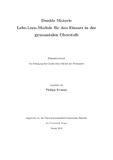Citation link:
http://dx.doi.org/10.25819/ubsi/10114Files in This Item:
| File | Description | Size | Format | |
|---|---|---|---|---|
| Dissertation_Philipp_Krumm.pdf | 25.22 MB | Adobe PDF |  View/Open |
| Dokument Type: | Doctoral Thesis | metadata.dc.title: | Dunkle Materie: Lehr-Lern-Module für den Einsatz in der gymnasialen Oberstufe | Other Titles: | Dark Matter: Teaching-learning modules for use in the senior high school | Authors: | Krumm, Philipp | Institute: | Fakultät IV - Naturwissenschaftlich-Technische Fakultät | Free keywords: | Astrophysics, Dark matter, Physics teaching | Dewey Decimal Classification: | 530 Physik | GHBS-Clases: | VDIS VEQ UMH UMD |
Issue Date: | 2022 | Publish Date: | 2022 | Abstract: | Beobachtungen und Befunde aus der Gravitationsphysik und der Kosmologie lassen darauf schließen, dass die uns bekannte Materie lediglich knapp 5% der gesamten Massendichte des Universums ausmacht. Die restlichen 95% sind bis heute nicht verstanden und legitimieren gleichermaßen die enormen Mühen, welche die moderne astronomische Forschung unternimmt, um diesen hohen Anteil an unbekannter Masse zu untersuchen. Ein beträchtlicher Teil scheint aus für uns nicht-sichtbarer Materie zu bestehen. Die Befunde zu dieser Dunklen Materie sind vielfältig und bieten damit ein großes didaktisches Potential. Dennoch wird in Schulen und auch in der Fachlehrerausbildung an Hochschulen häufig nur die Physik vermittelt, welche sich mit der bekannten, sichtbaren und überwiegend baryonischen Masse im Universum beschäftigt. Es sollte und muss ein klares Ziel des Physikunterrichts und des Physikstudiums für angehende Lehrkräfte sein, die bisherigen Erkenntnisse zur Hellen und zur Dunklen Materie zu vermitteln. Ziel der vorliegenden Arbeit ist es, Wege und Möglichkeiten aufzuzeigen, wie das Themengebiet der Dunklen Materie für Schülerinnen und Schüler sachgerecht aufbereitet werden kann. Dazu wird zunächst analysiert, inwieweit die Dunkle Materie in aktuellen Schulbüchern und ausgewählten Lehrplänen vertreten ist. Das Kapitel "Erhebungen" schließt ebenfalls Befragungen von Schülerinnen und Schülern sowie Lehrkräften ein, in welchen das Interesse und die fachlichen Kenntnisse bezogen auf die Dunkle Materie stichprobenhaft evaluiert werden. Aus den daraus gezogenen Kenntnissen werden anschließend drei Module entwickelt, die die Beobachtungen und Befunde aus der Gravitationsphysik (Modul 1), aus der Kosmologie (Modul 2) sowie die offenen Fragen und das sich daraus ergebende Diskussionspotential (Modul 3) thematisieren. Im Rahmen dieser Module werden durch Analogieexperimente mit einem vom Lernenden real vorzunehmenden Versuchsteil mit entsprechender Analysesoftware sowie durch Analogieexperimente, bei denen der Beobachtungsanteil besonders hoch ist, die fachlichen Grundlagen für Schülerinnen und Schüler in didaktisch reduzierter Weise zugänglich gemacht. Ergänzt wird dies durch mathematische Elementarisierungen und Simulationen. Die vorliegende Arbeit bietet außerdem Begleitmaterial in Form von vertiefenden Aufgaben für die Umsetzung im Unterricht, sodass vollwertige Lehr-Lern-Konzepte für unterrichtende und zukünftig unterrichtende Lehrkräfte in dieser Promotionsschrift bereitgestellt werden können. Der Verfasser hat diese Konzepte bereits im Unterricht eingesetzt, sodass zu den einzelnen Modulen auch eine Evaluation der unterrichtlichen Erprobung erfolgt. Observations and findings from gravitational physics and cosmology lead us to the assumption that the matter known to us only makes up just 5% of the total matter of the universe. The remaining 95% are still not understood and legitimize because of that reason the enormous effort of modern astronomical research in order to study this high proportion of unknown matter. A considerable part seems to consist of matter that is invisible to us. The findings on this dark matter are diverse and therefore offer great didactic potential. Nevertheless, only the physics that deals with the known, visible and largely baryonic masses in universe is often taught in schools and also in the teacher trainings at universities. It should and must be a clear aim of physics teaching and physics studies for prospective teachers to convey the previous knowledge about light and dark matter. The aim of the present work is to show ways and possibilities how the subject matter of dark matter can be properly prepared for pupils. First, it is analyzed how strongly dark matter is represented in current school books and selected curricula. This chapter also includes surveys of pupils and teachers, in which the interest and knowledge related to dark matter are randomly evaluated. Based on the results gained from this, three modules are developed that treat the observations and findings from gravitational physics (module 1), from cosmology (module 2) as well as the open questions and the resulting potential for citical discussions (module 3). In this context, the foundations are made accessible to pupils in a didactically reduced manner by means of analogy experiments, mathematical elementalizations and simulations. The analogy experiments are either real experiments with corresponding evaluation by developed software or experiments in which the observation portion is particularly high. The present work also offers exercises and additional material for implementation in the lessons. All in all full teaching-learning concepts for teachers and future teachers can be provided in this doctoral thesis. The author has already used these concepts in the classroom so that the individual modules are also evaluated in the course of teaching trials. |
DOI: | http://dx.doi.org/10.25819/ubsi/10114 | URN: | urn:nbn:de:hbz:467-22036 | URI: | https://dspace.ub.uni-siegen.de/handle/ubsi/2203 |
| Appears in Collections: | Hochschulschriften |
This item is protected by original copyright |
Page view(s)
615
checked on Nov 28, 2024
Download(s)
608
checked on Nov 28, 2024
Google ScholarTM
Check
Altmetric
Items in DSpace are protected by copyright, with all rights reserved, unless otherwise indicated.

